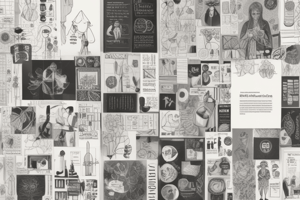Podcast
Questions and Answers
Which principle ensures that every visual element serves a purpose?
Which principle ensures that every visual element serves a purpose?
- Contrast
- Hierarchy
- Clarity (correct)
- Alignment
The principle of contrast is primarily concerned with the arrangement of elements.
The principle of contrast is primarily concerned with the arrangement of elements.
False (B)
What does visual hierarchy signify in design?
What does visual hierarchy signify in design?
The importance of elements in a design.
To create order and organization in a design, proper __________ is essential.
To create order and organization in a design, proper __________ is essential.
Match the following principles with their descriptions:
Match the following principles with their descriptions:
Which principle helps to create a strong focus on important elements through differences?
Which principle helps to create a strong focus on important elements through differences?
Proximity is a Gestalt principle that states elements close to each other are perceived as unrelated.
Proximity is a Gestalt principle that states elements close to each other are perceived as unrelated.
Name one Gestalt principle related to how people perceive visual elements.
Name one Gestalt principle related to how people perceive visual elements.
Which of the following is NOT a form of communication?
Which of the following is NOT a form of communication?
Visual communication can only be static and does not include dynamic forms.
Visual communication can only be static and does not include dynamic forms.
What is the primary goal of visual communication?
What is the primary goal of visual communication?
An example of visual communication that combines text, images, and data visualization is called an __________.
An example of visual communication that combines text, images, and data visualization is called an __________.
Match the following forms of communication with their primary characteristics:
Match the following forms of communication with their primary characteristics:
Which factor does NOT influence communication?
Which factor does NOT influence communication?
Effective communication requires feedback to ensure the message is interpreted correctly.
Effective communication requires feedback to ensure the message is interpreted correctly.
What visual element is often used to convey a brand’s identity?
What visual element is often used to convey a brand’s identity?
What is one reason why visuals are more effective than text?
What is one reason why visuals are more effective than text?
Visual communication can help simplify complex information.
Visual communication can help simplify complex information.
What is one component of visual communication that involves the design and arrangement of text?
What is one component of visual communication that involves the design and arrangement of text?
A red circle with a diagonal line through it is understood as __________.
A red circle with a diagonal line through it is understood as __________.
Match the following benefits of visual communication with their descriptions:
Match the following benefits of visual communication with their descriptions:
Which of the following is NOT a benefit of visual communication?
Which of the following is NOT a benefit of visual communication?
High-quality images are not essential for effective visual communication.
High-quality images are not essential for effective visual communication.
Name one field where visual communication is particularly valuable.
Name one field where visual communication is particularly valuable.
Flashcards
Visual Hierarchy
Visual Hierarchy
The principle of making the most important information stand out.
Contrast
Contrast
Using differences in color, size, shape, or texture to make things stand out.
Alignment
Alignment
Arranging elements on a page to create a clean and organized look.
Clarity
Clarity
Signup and view all the flashcards
Gestalt Principles
Gestalt Principles
Signup and view all the flashcards
Animation
Animation
Signup and view all the flashcards
Visual Communication
Visual Communication
Signup and view all the flashcards
Principles of Visual Communication
Principles of Visual Communication
Signup and view all the flashcards
What is Communication?
What is Communication?
Signup and view all the flashcards
What is Visual Communication?
What is Visual Communication?
Signup and view all the flashcards
Evolution of Visual Communication
Evolution of Visual Communication
Signup and view all the flashcards
Visual Communication Transcends Language Barriers
Visual Communication Transcends Language Barriers
Signup and view all the flashcards
Visuals Simplify Complexity
Visuals Simplify Complexity
Signup and view all the flashcards
Typography in Visual Communication
Typography in Visual Communication
Signup and view all the flashcards
Images in Visual Communication
Images in Visual Communication
Signup and view all the flashcards
Visuals Evoke Emotions and Influence Behaviour
Visuals Evoke Emotions and Influence Behaviour
Signup and view all the flashcards
Visuals are Processed Faster and Remembered Better
Visuals are Processed Faster and Remembered Better
Signup and view all the flashcards
Visuals Increase Engagement and Retention
Visuals Increase Engagement and Retention
Signup and view all the flashcards
Visual Communication Across Diverse Fields
Visual Communication Across Diverse Fields
Signup and view all the flashcards
Study Notes
What is Communication?
- Communication is the exchange of information, thoughts, ideas, or feelings between individuals or groups.
- It involves a sender encoding a message and a receiver decoding it.
- Communication can be verbal (spoken or written language) or nonverbal (body language, facial expressions).
- Effective communication requires clarity, understanding, and feedback.
- It enables collaboration, relationship-building, problem-solving, and decision-making.
What is Visual Communication?
- Visual communication is a subset of communication that conveys ideas and information through visual elements.
- It ranges from simple signs and symbols to complex multimedia.
- It can be static (posters, photos) or dynamic (videos, animations).
- Visual communication is ubiquitous in modern society (advertising, education, design).
- Its goal is to make communication engaging, memorable, and accessible.
- Examples include infographics, logos, and other visual aids.
Evolution of Visual Communication
- Prehistoric Era: Cave paintings (Lascaux, France, ~15,000 BCE) depicted hunting, animals, and symbols, possibly for storytelling or rituals.
- Ancient Civilizations: Hieroglyphics (Egypt) and cuneiform (Sumerians) were early writing systems using pictures and symbols for religious texts, official decrees, and record-keeping.
- Classical Antiquity: Greeks and Romans used art, architecture, and public inscriptions to depict stories and convey information about everyday life, gods, heroes, and politics.
- Medieval Period: Illuminated manuscripts (Book of Kells) combined visuals and text for religious purposes.
- Renaissance: Artists like Leonardo da Vinci and Michelangelo mastered perspective and realism in visual storytelling. Johannes Gutenberg's printing press made visual communication more widespread.
- Industrial Revolution: Lithography and later photography allowed for mass production of images, making advertising and visual communication more accessible.
- 20th Century to Present: Graphic design emerged as a profession. Digital technology revolutionized visual communication.
Why is Visual Communication Important?
- Speed of Information Transfer: Visuals are processed faster than text.
- Enhanced Retention: People remember visuals better than text.
- Universal Understanding: Visuals can transcend language barriers.
- Engagement and Persuasion: Visuals can evoke emotions and influence behavior.
- Clarification and Emphasis: Visuals can simplify complex information and highlight key points.
Components of Visual Communication
- Images: Powerful tools for conveying emotions, telling stories, and representing concepts.
- Typography: The design and arrangement of text (font, size, spacing, alignment).
- Color: Evokes emotions and has cultural associations.
- Layout and Composition: Arrangement of visual elements, influencing readability and flow.
- Symbols and Icons: Simplified images representing ideas, actions, or objects.
- Motion and Animation: Adds dynamism.
- Gestalt Principles: How people perceive visual elements as unified wholes (proximity, similarity, closure).
Types of Visual Communication
- Graphic Design: Planning and projecting ideas using visuals and text.
- Infographics: Visual representations of information, data, and knowledge.
- User Interface (UI) Design: Creating visual layouts and interactive elements for digital products.
- Photography and Videography: Capturing moments and conveying messages through images and moving pictures.
- Illustration: Creating custom illustrations to represent concepts, ideas, and stories.
- Motion Graphics: Using video and animation to convey information or tell stories.
- Signage and Wayfinding: Guiding people through physical spaces using visual cues.
- Advertising and Marketing: Visual tools for advertising products and services.
- Data Visualization: Representing data graphically to make patterns and trends easier to understand.
- Packaging Design: Creating the exterior of a product to make it appealing.
Principles of Visual Communication
- Clarity: Meaning should be easily understandable.
- Contrast: Highlighting important elements through differences in color, size, or shape.
- Alignment: Arranging elements for a clear and organized look.
- Hierarchy: Visual hierarchy signifies importance through size, color, and placement.
- Balance: Visual weight distribution in a design, creating a stable and harmonious feel.
- Proximity: Placing related elements closer together.
- Repetition: Using similar elements to create cohesion.
- White Space: Empty space around and between elements to reduce clutter and attract attention to key points.
Studying That Suits You
Use AI to generate personalized quizzes and flashcards to suit your learning preferences.




